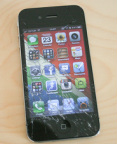|
Yuch!
An average adult can touch as many as 30 objects within a minute, including germ-harboring, high-traffic surfaces such as light switches, doorknobs, phone receivers, and remote controls. At home, you do all that you can to keep the germs at bay. But what happens when you step out the door to go to dinner, do some grocery shopping, or visit the doctor’s office? Know where germs are most likely to lurk, as you’ll find out here. Restaurant menus Have you ever seen anyone wash off a menu? Probably not. A recent study in the Journal of Medical Virology reported that cold and flu viruses can survive for 18 hours on hard surfaces. If it’s a popular restaurant, hundreds of people could be handling the menus–and passing their germs on to you. Never let a menu touch your plate or silverware, and wash your hands after you place your order. Lemon wedges According to a 2007 study in the Journal of Environmental Health, nearly 70% of the lemon wedges perched on the rims of restaurant glasses contain disease-causing microbes. When the researchers ordered drinks at 21 different restaurants, they found 25 different microorganisms lingering on the 76 lemons that they secured, including E. coli and other fecal bacteria. Tell your server that you’d prefer your beverage sans fruit. Why risk it? Condiment dispensers It’s the rare eatery that regularly bleaches its condiment containers. And the reality is that many people don’t wash their hands before eating, says Kelly Reynolds, PhD. So while you may be diligent, the guy who poured the ketchup before you may not have been, which means his germs are now on your fries. Squirt hand sanitizer on the outside of the condiment bottle or use a disinfectant wipe before you grab it. Holding the bottle with a napkin won’t help; napkins are porous, so microorganisms can pass right through, Reynolds says. from ABC News….
0 Comments
 Although reusable grocery bags are good for our Earth, there is a hidden danger of germs building up in them and transferring to new purchases. A good article in in boston.com, from the Boston Globe, discusses an incident where several people became infected with the norovirus and it was linked to a reusable grocery bag. Here is some of what the article said: “A 2010 norovirus outbreak that occurred in 17 teenage girls from Oregon and their four adult chaperones who attended an out-of-state soccer tournament was traced to a bag containing post-game snacks. It turns out the bag had been stored in a hotel bathroom that had been used by a player who suddenly became ill on the trip with diarrhea and vomiting; the girl, infected with norovirus, had no direct contact with her teammates after her symptoms began. The rest of the team became sick several days later, and researchers at Oregon Health and Science University traced their infections to contaminated bags of chips, grapes, and cookies. “The virus aerosolized in the bathroom and landed on the grocery bag,” explained study co-author Kimberly Repp. “It was then transported into the team room where snacks were passed around and then got on the players’ hands when they touched the snack packages.” Repp was able to isolate norovirus from the reusable grocery bag two weeks after the soccer match, though, she said she didn’t know whether the virus was alive and still capable of infecting someone.”  One out of every six cell phones is contaminated with germs from human feces, a recent British study found. Read the whole story at colekcolek.com where it states: Fecal bacteria can survive on hands for hours at a time, especially in warm temperature away from sunlight. Germs were easily transferred by touch on the doorknob, food, and even cell phones. Germs can then move on to someone else. Every year, children under age five died by pneumonia and diarrheal diseases, which can actually be prevented by the simple act of washing hands with soap. In developed countries, wash hands with soap helps people to prevent the spread of viral infections, such as norovirus, rotavirus, and influenza |
Not Medical Advice
Everything in this blog is for entertainment and information only. It is NOT medical advice. Do not consider anything as medical advice and check with your physician before you take any action from any of our posts.
Categories
All
Archives
March 2020
AuthorI'm not in medicine. I'm just a mild germaphobe sharing information that I find. Interesting Sites |
 RSS Feed
RSS Feed
